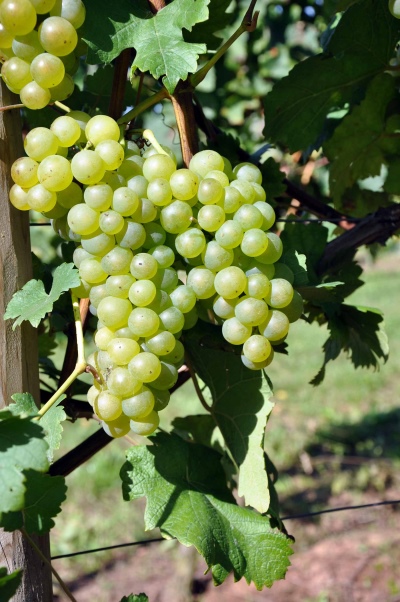
- Appointment: dining room
- Berry color: yellow-green, with a moderate waxy bloom, golden tint and brown spots
- Taste: pleasant, harmonious
- With bones: Yes
- Ripening period: early
- Ripening period, days: 125
- Frost resistance, ° C: -18
- Name synonyms: Simple birch, Beyaz Gutedel, Golden Chasselas, Gutedel weisser, Dinka white, Zlatina, Campanella bianca, Queen Victoria, Mornan blanc, Rosemaryintraube, Chassela blanc, Chassela dore, Feger white, Edward, Fondation
- Bunch weight, g: 193
- Flower type: bisexual
Grapes may not grow in all climates, and developers are working to overcome this limitation. Shasla Belaya is one of the earliest varieties, moreover, it is an attractive table hybrid. The variety deserves maximum attention and careful study.
Breeding history
This is one of the oldest varieties. It is known about its cultivation in ancient Egypt. Today the plant can be seen in the vineyards of the Mediterranean states (and not only them). For a long time it occupied a leading position among table breeds. According to modern data, this culture in the past was distributed throughout northern Africa; the latest variants are clones bred in different states.
Description
Ripening period
No more than 125 days pass between the ejection of the buds and the readiness for harvesting. Under favorable cultivation conditions, this period is reduced to 105 days. The high intensity of ripening of annual varieties is characteristic. South of the middle lane, maturity occurs in late summer or in the first two weeks of autumn. To the north, the cultivation of Shasly White can be difficult.
Bunches
They are often cone-shaped. But there are also brushes of a combined (transitional from a cylinder to a cone) shape. Bunches can be dense, and moderately dense varieties are also found. The average weight of the hand is 193 g.
Berries
The grapes are yellow-green in color. They are characterized by a limited wax bloom. Sometimes golden notes and brown inclusions are found. The fruit contains seeds inside. The pulp is tender, melts on the tongue; with a length of 1.5-1.7 cm, the width of the fruit is 1.5-1.6 cm.
Taste
Shasla Belaya is liked by almost all consumers, it leaves an impression of harmony. A tasting examination gives this variety of grapes an estimate of 7.5 to 8 units. The aroma is not detectable. The pulp is quite tender. There are almost no dissatisfied people.
Yield
During the harvesting of fruits, Chasla Belaya usually pleases the growers. The fertility of the variety is stable under more or less normal conditions. About 60% of the branches contain berries. 1 shoot can develop from 0.9 to 1.6 bunches.


Growing features
Landing
The variety can be grown on the same soil as any other unpretentious grape variety. Agronomists consider warm loamy slopes to be the optimal choice. Sandy loam, ordinary sandy soils also turn out to be a good option. The distance between adjacent holes should be 1.25 m.The use of row spacings less than 2.5 m is not allowed, but it is hardly reasonable to widen them too much.

Pollination
The bisexualness of flowers reliably insures against almost any problems with pollinators. Only under bad weather conditions do you sometimes have to pollinate flowers with your hands. The timing of the onset of flowering is not as strictly related to the timing of fruiting as is often thought. For active breeding experiments, it is important to keep constant observations. Manual pollination, if necessary, is repeated at least 3 times.
Pruning
This procedure usually leaves 5, 6 or 7 eyes. It is necessary to take up the scissors for the first time after the completion of the leaf fall. Early pruning, anticipating the movement of juices, is accompanied by the removal of all branches, except for the main pair. On one shoot, a couple of buds are retained, on the other, twice as many. In the second growing season, only a couple of central branches are preserved.



Frost resistance and the need for shelter
The culture survives cooling down to -18 degrees. Replacement branches guarantee decent fruiting. It is necessary to protect the culture in winter in the middle lane and to the north.

Diseases and pests
Fungal infection is unlikely, especially with proper agricultural technology. But this does not mean that there is no need for processing. Susceptibility to mildew is characteristic. Spotted necrosis is also a formidable danger. And also the threat is:
bacterial cancer;
gray rot;
phylloxera;
grape leaf roll.

If a grape is exposed to any disease or insect, this always affects its appearance.
Storage
Most often, the crop is consumed fresh, or immediately sent for processing. Transportation of fruits is allowed. Chasla White can be stored in refrigerators for 60 to 90 days. These circumstances make the plant an attractive choice for industrial cultivation.











































































